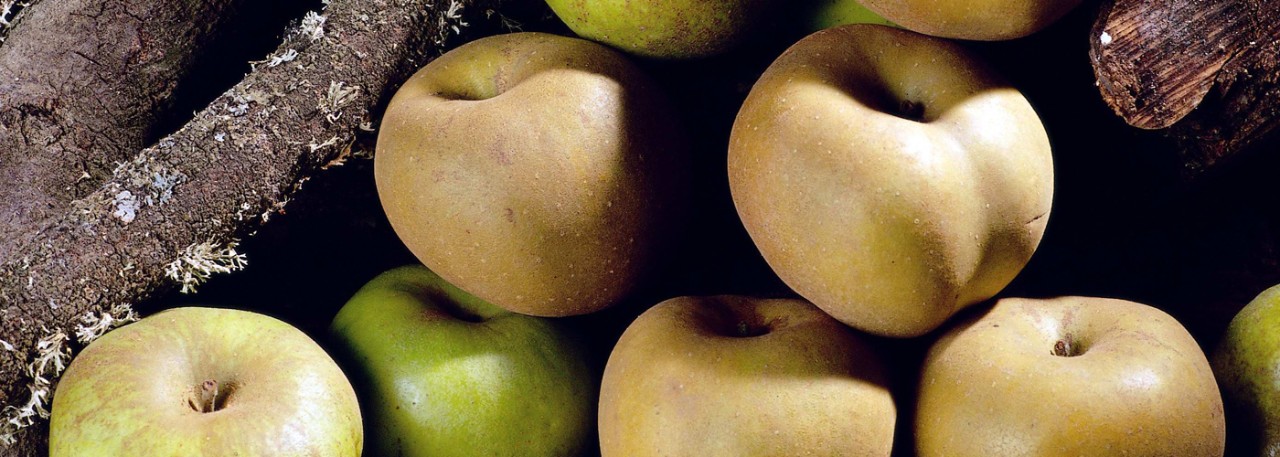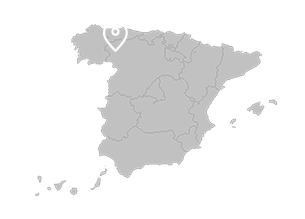.png.transform/rendition-xs/image_image%20(1).png)
Manzana Reineta del Bierzo PDO
Apples (from the Malus domestica Borkh species) from the Blanca or Reineta del Canadá and Reineta Gris varieties, destined for fresh human consumption.
Tasting notes
Great flavor with a mix of aromas and average intensity. Characteristic slightly acidic nasal and retro-nasal aromas, with notes of grass, ripe apples and vanilla. Crisp or very crisp apples, with no floury traces when bitten into. This is a very juicy fruit, sweet or very sweet and with a fairly intense acidic taste.
Other notes
Its external appearance shows a flattened fruit, symmetrical and more wide than tall, with a short stalk and a closed base cavity. When harvested the apple's color is green with no shine and displays typical surface russeting, which sets it apart from other reineta apples at first sight. The fruit’s flesh has a typically creamy color.
Its particular physical and organoleptic characteristics are focused on the very sweet flesh, high sugar content and the balance between acidity and sweetness. This apple has five times more vitamin C than any other apple.
The reineta is included in the list of large fruit varieties. It is a characteristically flat apple, with a height/width ratio of approximately 0.70. Other forms which may appear, with a lower ratio, are the round-flat and conical-round-flat forms.
When sent to market, the apples must exhibit the following physical and chemical properties: flesh firmness measured with an 11-meter piston, superior to 7 kg (15.4 lbs), refractometric index superior to 14º brix, acidity superior to 7g (0.2 oz) of malic acid/l.
Production / Processing method
Plantations suitable for production must be located at an altitude lower than 750 m (2,460 ft), on soils with pH higher than six and with a minimum age of six years. Maximum efficiency criteria are followed when working the vegetation layer, irrigation and pest and disease control. Adequate fertilization is used to ensure the balance and levels of nutrients in the plant, and thinning methods are used only when necessary to regulate production.
Harvesting takes place when the physical, chemical and organoleptic characteristics of the fruit meet the parameters defined for the optimum harvesting period. The methodology used in harvesting, as well as the systems used for transport, ensure that the apples are not damaged in any way.
The techniques and systems used for the preservation, treatment and packaging of the fruit allow the physical, chemical and organoleptic qualities of the apples protected by the Designation of Origin to be maintained.
Geography / Relief and climate
The area is a tectonic groove surrounded by a mountainous belt. It is only via the Sil Valley that the groove can be exited without any great difficulty. The Bierzo region ranges from an altitude of 340 m (1,115 ft) to 2,117 m (6,945 ft), and the average altitude at the heart of the production area is approximately 600 m (1,968 ft) above sea level.
The area’s climate is determined by the influence of both the Atlantic and the Mediterranean. The north-westerly winds reach the Bierzo area and explain its link to Spain's wetter areas. The mountainous barrier that surrounds the depression gives it a thermal system which is much more favorable than that of the Meseta plateau. Its latitude is located between 42° 20' and 42° 50', and has a direct influence on the distribution of hours of sunshine throughout the year, a highly important factor for the development of the reineta apple’s cycle.
There is a direct correlation between the number of hours of sunshine, along with solar radiation and the area’s temperature, and the levels of soluble solids and sugars in the apple, and therefore its acidity-sweetness contrast and its flavor. The factor that determines the firmness of the flesh is climatic in origin - the combination of temperature and humidity at the moment when the apple ripens. Harvesting normally begins between the 8th and the 15th of September. The contrast between the high daytime temperatures in the summer (around 27 ºC (80.6 ºF)) and the cool nocturnal temperatures around the harvest period (approximately 13 ºC (55.4 ºF)) determine the apple's firmness and characteristic texture.
Rainfall in the months of August and September leads to high levels of relative atmospheric humidity, with the presence of morning fogs. This humidity normally leads to superficial russeting, which is highly characteristic of the reineta apples produced in the Bierzo area, and does not naturally occur in apples from other production areas.
Regulatory Council
Consejo Regulador de la DOP Manzana Reineta del Bierzo
C/ La Iglesia, 2
24549 Carracedelo (León)
Tel: (+34) 987 562 866
Fax (+34) 987 562 869
info@manzanareinetadelbierzo.es
www.manzanareinetadelbierzo.es
Sources:
This apple has five times more vitamin C than any other apple.


- /content/dam/en/icex-foodswines/images/products/fruits---vegetables/manzana-reineta-del-bierzo-pdo/Manzana%20Reineta%20del%20Bierzo%20PDO%20carr1.jpg
- /content/dam/en/icex-foodswines/images/products/fruits---vegetables/manzana-reineta-del-bierzo-pdo/Manzana%20Reineta%20del%20Bierzo%20PDO%20carr2.jpg

Carracedelo (Castile-Leon)
